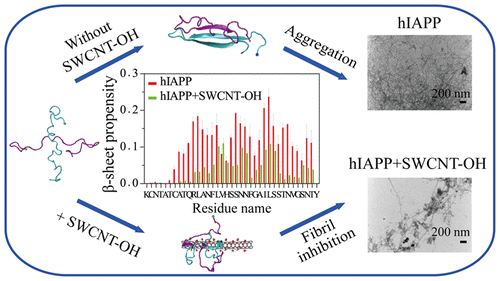当前位置:
X-MOL 学术
›
ACS Chem. Neurosci.
›
论文详情
Our official English website, www.x-mol.net, welcomes your
feedback! (Note: you will need to create a separate account there.)
The Inhibitory Effect of Hydroxylated Carbon Nanotubes on the Aggregation of Human Islet Amyloid Polypeptide Revealed by a Combined Computational and Experimental Study.
ACS Chemical Neuroscience ( IF 4.1 ) Pub Date : 2018-07-23 , DOI: 10.1021/acschemneuro.8b00166 Yuxiang Mo 1, 2 , Sayanti Brahmachari 3 , Jiangtao Lei 1 , Sharon Gilead 3 , Yiming Tang 1 , Ehud Gazit 3 , Guanghong Wei 1
ACS Chemical Neuroscience ( IF 4.1 ) Pub Date : 2018-07-23 , DOI: 10.1021/acschemneuro.8b00166 Yuxiang Mo 1, 2 , Sayanti Brahmachari 3 , Jiangtao Lei 1 , Sharon Gilead 3 , Yiming Tang 1 , Ehud Gazit 3 , Guanghong Wei 1
Affiliation

|
Fibrillar deposits formed by the aggregation of the human islet amyloid polypeptide (hIAPP) are the major pathological hallmark of type 2 diabetes mellitus (T2DM). Inhibiting the aggregation of hIAPP is considered the primary therapeutic strategy for the treatment of T2DM. Hydroxylated carbon nanoparticles have received great attention in impeding amyloid protein fibrillation owing to their reduced cytotoxicity compared to the pristine ones. In this study, we investigated the influence of hydroxylated single-walled carbon nanotubes (SWCNT-OHs) on the first step of hIAPP aggregation: dimerization by performing explicit solvent replica exchange molecular dynamics (REMD) simulations. Extensive REMD simulations demonstrate that SWCNT-OHs can dramatically inhibit interpeptide β-sheet formation and completely suppress the previously reported β-hairpin amyloidogenic precursor of hIAPP. On the basis of our simulation results, we proposed that SWCNT-OH can hinder hIAPP fibrillation. This was further confirmed by our systematic turbidity measurements, thioflavin T fluorescence, circular dichroism (CD), transmission electron microscope (TEM), and atomic force microscopy (AFM) experiments. Detailed analyses of hIAPP-SWCNT-OH interactions reveal that hydrogen bonding, van der Waals, and π-stacking interactions between hIAPP and SWCNT-OH significantly weaken the inter- and intrapeptide interactions that are crucial for β-sheet formation. Our collective computational and experimental data reveal not only the inhibitory effect but also the inhibitory mechanism of SWCNT-OH against hIAPP aggregation, thus providing new clues for the development of future drug candidates against T2DM.
中文翻译:

计算和实验研究相结合揭示了羟基化碳纳米管对人胰岛淀粉样多肽聚集的抑制作用。
由人类胰岛淀粉样多肽(hIAPP)聚集形成的原纤维沉积物是2型糖尿病(T2DM)的主要病理标志。抑制hIAPP的聚集被认为是治疗T2DM的主要治疗策略。羟基化碳纳米颗粒由于与原始蛋白相比具有较低的细胞毒性,因此在阻止淀粉样蛋白原纤化方面受到了广泛的关注。在这项研究中,我们研究了羟基化的单壁碳纳米管(SWCNT-OHs)对hIAPP聚集的第一步的影响:通过执行显式溶剂副本交换分子动力学(REMD)模拟进行二聚。广泛的REMD模拟表明,SWCNT-OHs可以显着抑制肽间β-折叠的形成,并完全抑制hIAPP的先前报道的β-发夹淀粉样蛋白形成前体。根据我们的模拟结果,我们提出SWCNT-OH可以阻碍hIAPP的原纤化。我们的系统浊度测量,硫黄素T荧光,圆二色性(CD),透射电子显微镜(TEM)和原子力显微镜(AFM)实验进一步证实了这一点。对hIAPP-SWCNT-OH相互作用的详细分析表明,hIAPP与SWCNT-OH之间的氢键,范德华力和π堆积相互作用显着削弱了对β-折叠形成至关重要的肽间和肽内相互作用。
更新日期:2018-07-09
中文翻译:

计算和实验研究相结合揭示了羟基化碳纳米管对人胰岛淀粉样多肽聚集的抑制作用。
由人类胰岛淀粉样多肽(hIAPP)聚集形成的原纤维沉积物是2型糖尿病(T2DM)的主要病理标志。抑制hIAPP的聚集被认为是治疗T2DM的主要治疗策略。羟基化碳纳米颗粒由于与原始蛋白相比具有较低的细胞毒性,因此在阻止淀粉样蛋白原纤化方面受到了广泛的关注。在这项研究中,我们研究了羟基化的单壁碳纳米管(SWCNT-OHs)对hIAPP聚集的第一步的影响:通过执行显式溶剂副本交换分子动力学(REMD)模拟进行二聚。广泛的REMD模拟表明,SWCNT-OHs可以显着抑制肽间β-折叠的形成,并完全抑制hIAPP的先前报道的β-发夹淀粉样蛋白形成前体。根据我们的模拟结果,我们提出SWCNT-OH可以阻碍hIAPP的原纤化。我们的系统浊度测量,硫黄素T荧光,圆二色性(CD),透射电子显微镜(TEM)和原子力显微镜(AFM)实验进一步证实了这一点。对hIAPP-SWCNT-OH相互作用的详细分析表明,hIAPP与SWCNT-OH之间的氢键,范德华力和π堆积相互作用显着削弱了对β-折叠形成至关重要的肽间和肽内相互作用。











































 京公网安备 11010802027423号
京公网安备 11010802027423号